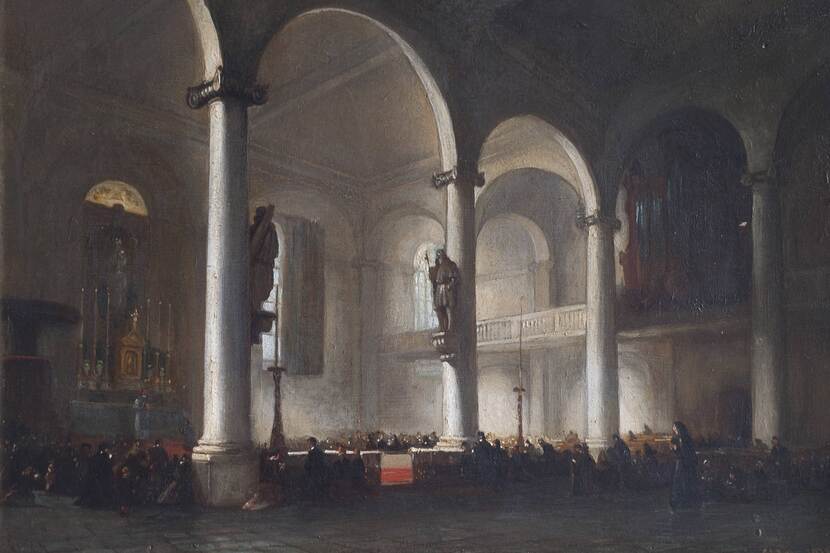Archaeological research to begin around crypt of Court Chapel
On 10 July, archaeological research will begin in and around the crypt of the former Court Chapel in the Binnenhof complex. Set to last two months, the research will take place in the cellars under the Senate and outdoors in an area known as the Opperhof, which measures about 40m2 and is situated near the Senate and close to the Ministry of General Affairs. The information panels at the site of the ongoing renovation of the Binnenhof will be shifted to allow a view of the archaeology work while it is under way outdoors. You can also follow the research here at binnenhofrenovatie.nl.

Rich in history
The aim of the research is to learn more about the history of the former Court Chapel, founded by Count Floris V in 1289, and about the tradition of burials at the site. Archaeological finds are bringing much to light about the Binnenhof's rich 800-year history. They also give insights into the Netherlands’ development as a nation. At the request of the Central Government Real Estate Agency, the archaeology department of the municipality of The Hague is carrying out the research in close collaboration with the municipality’s Historic Monuments Preservation Department and the Cultural Heritage Agency (RCE). The archaeological research around the crypt is not part of the general renovation of the Binnenhof, although the ongoing renovation work has made it possible to access the space.
Curious
Andjelko Pavlovic, an archaeologist working for the municipality of The Hague, is curious to see what the research will turn up. ‘Of course we hope to find graves so that we can study them based on what we know already and by using the latest technology. If there are any grave markers made of natural stone, we hope to be able to date them and link them to the specific people for whom they were made. But each day will bring new surprises in terms of what we find and what obstacles we encounter. That’s all in a day’s work for archaeologists.’
According to the Cultural Heritage Agency's 2019 report ‘The remains of Johan van Oldenbarnevelt’, the lack of a modern DNA match means it would not be possible to identify any remains as Van Oldenbarnevelt’s. For this reason, the agency had already decided to focus the research on documenting as much of the site's rich hidden history as they can.
Government ambitions
The research is in line with the government’s ambitions to increase the focus on historic sites. It also ties in with a motion submitted by MP Sandra Beckerman calling for the wider public to be more involved in and informed about archaeological research.
During the Ministry of General Affairs’ budget debate on 10 October 2018, the Prime Minister agreed to a request by then MP Ronald van Raak that the government examine the possibility and feasibility of an investigation of historic graves under the former Court Chapel. After letters to parliament were submitted by then culture minister Ingrid van Engelshoven on 8 July 2020 and state secretary Raymond Knops on 16 December 2021 to define the scope of the project, work is now under way.
What will happen?
Exterior: 10 July to 4 August
Excavation of the upper 60 centimetres of earth from the site will begin in the week of 10 July. Ideally, this will reveal the first glimpse of stone grave markers. The archaeologists will then measure, describe, photograph and scan the stones.
Digging will penetrate deeper layers in the following two weeks, and the team will map and investigate the underlying earth and make 3D images of the graves. Any skeletal remains or stones found will be removed for examination by specialist researchers.
The last week of the dig has been set aside as extra time if needed. Updates on how the work is proceeding will appear regularly on www.binnenhofrenovatie.nl. People can also watch the archaeologists at work at the Binnenhof from behind a transparent screen, accessed from the side closest to the Mauritshuis.
Interior: 28 August to 8 September
A scan will be made of the floors and cellar wall, after which architects will consult with the city's Historic Monuments Preservation Department on drilling holes, as described in state secretary Knops’ letter to parliament of 16 December 2021. In the final week cameras will be passed through the holes to photograph the spaces behind them. Updates on www.binnenhofrenovatie.nl will show as much of this work as possible, although this will depend on the results of the scans and technical limitations.
The future of the finds
Finds such as building foundations and stone grave markers will be scanned and documented. In principle, archaeological finds such as these, which can be preserved where they lie, will be left in situ. Artefacts that are not fixed in place will be cleaned, conserved and restored. They will then be stored in the municipality’s archaeological depot, where they will remain available for research and exhibition, including in the information centre for the Binnenhof restoration, due to open this year at Plaats 22 in The Hague.